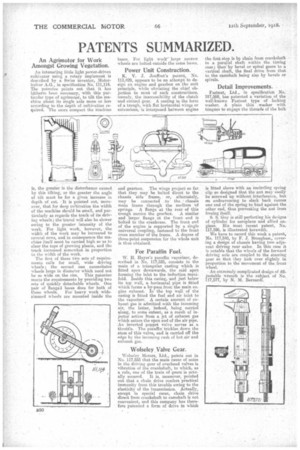PATENTS SUMMARIZED.
Page 22

If you've noticed an error in this article please click here to report it so we can fix it.
• An Agrimotor for Work Amongst Growing Vegetation.
An interesting little light power-driven cultivator using a rotary implement is described by a Swiss inventor, Motorkidtur A.G., in specification No. 111,114. The patentee points out that it, has hitherto been necessary, with this patlice Inctype of agriniotor, to tilt the machine about its single axle more or. less according to the depth of cultivation required. The more compact the machine is, the greater is the disturbance caused by this tilting, or the greater the angle: of tilt must be for a given increase in depth of cut. : It is pointed out, moreover, that for deep cultivation the width of the machine should be small, and particularly as regards the trick of its driving wheels; thetravel will also be slower owing to the greater intensity of the work. For light work, however, the width of the work may be increased to several rows, and in consequence the machine itself must be carried high so'as to clear the tops of growing plants, and the track increased somewhat in proportion to the width of the work. The first of these two sets of requirements calls for small, wide driving wheels; the second one necessitates wheels large in diameter which need not be 40 wide on the rim. This patentee meets the requirements by providing two sets of quickly detachable wheels. One pair of flanged bases does for both of these wheels. For heavy work widerimmed \I heels are mounted insidethe irises. For light work-large narrow wheels are bolted outside the same bases.
Power Unit Construction.
K. V. J. Jouffret's patent, No. 113,429, appears to be an attempt to design an engine and gearbox on the unit principle, while obviating the .chief ob, jection to most of such constructions, namely, the inaccessibility of the clutch and control gear. A casting in the form of a trough, with flat horizontal wings or extensions, is interposed between engine and gearbox. The wings project) so far that they may he bolted direct to the chassis side frame, or, alternately, may be connected to the chassis main frame thrpugh the medium of springs. A flange at the rear of this trough carries the gearbox. A similar and ,larger flange at the front end is bolted to the crankcase. The front end of the engine is supported by a single universal coupling, fastened to the front cross member-of the frame. A degree of three-point suspension for the whole unit is thus obtained.
For Paraffin Fuel.
W. H. IlaTes's paraffin vaporizer, described in No. 117,525, consists in the main of a triangular casting which is fitted apex downwards, the said apex forming the inlet to the induction manifold. Inside this casing, and just below its top wall, a horizontal pipe is fitted which forms a by-pass from the main engine exhaust. In the top wall of the casing is fitted the fuel and air inlet to the vaporizer. A certain amount of exhaust gas is admitted with the ineoming air, the latter, indeed, .being carried along, to some extent, as a result of injector action from a jet of exhaust gas which enters the open end of the air pipe. An inverted poppet valve serves as . a throttle. The paraffin trickles down the stem of this valve, and is carried off the edge by the incoming rush of hot air and exhaust gas.
Wolseley Valve Gear.
Wolselev Motors, Lid., points out in No. 117,5..93 that the main cause of noise in the driving gear of overhead valves is vibration of the crankshaft, to which, as a rule, one of the train of gears is actu
ally secured. It is, moreover, pointed out that a chain drive confers practical immunity from this trouble owing to the elasticity of the transmission. Actually, except in special cases, chain drive direct from crankshaft to camshaft is not convenient, and this company has therefore patented a form of drive in which
the first step is las chain from crankshaft to a parallel shaft within the timing case; then by bevel or spiral gears to a vertical shaft, the final drive from that to the camshaft being also by bevels or spirals.
Detail Improvements.
Fastnut, Ltd., in specification No 117,56B, has patented a variation of the well-known Fastnut type of locking washer. A plain thin .washer with tongue's to engage the threads of the bolt is fitted above with an encircling spring clip so designed that the nut may easily be screwed up without interference, but on endeavouring to slack back causes one end of the spring to bind against the other end, thus preventing the nut from freeing itself. S. 5: Guy is still perfecting his designs of cylinder for aeroplane and allied engines. His most recent patent, No. 117,596, is illustrated herewith. We have to record this week a patent, No. 117,540, by F. J. Brougham, covering a design of chassis having two adjacent driving rear axles. In this ease it is notable that the wheels of the forward driving axle are coupled to the steering gear so that they luck over slightly in proportion to the movement of the front wheel. An extremely complicated design of rdjustable wrench is the subject of No. 117,577, by N. M. Bernardi.






















